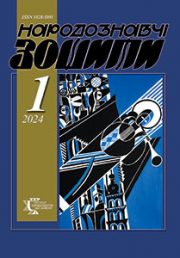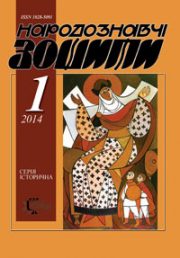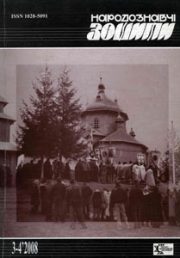The Ethnology Notebooks. 2023. № 2 (170), 287—298
UDK316:167(316.77+314.7)
DOI https://doi.org/10.15407/nz2023.02.287
MARKOV Ihor
- kandydat nauk (PhD equivalent) in History,
- Senior Research Fellow,
- The Ethnology Institute
- National Academy of Sciences of Ukraine,
- Social Anthropology Department,
- 15, Svobody avenue, 79000, Lviv, Ukraine,
- Contacts: e-mail: igor.markow@gmail.com
Academic Editors:
ZAREMBA-KOSOVYCH Hanna
- ORCID ID: https://orcid.org/0000-0003-3984-879X
- kandydatka nauk (PhD equivalent) in Sociology
- Research Fellow,
- The Ethnology Institute
- National Academy of Sciences of Ukraine,
- Social Anthropology Department,
- 15, Svobody avenue, 79000, Lviv, Ukraine,
- Contacts: e-mail: ganna.zaremba@gmail.com
SUDYN Danylo
- ORCID ID: https://orcid.org/0000-0001-5648-0224
- kandydat nauk (PhD equivalent) in Sociology
- Associate Professor at Sociology Department
- Ukrainian Catholic University;
- Research Fellow,
- The Ethnology Institute
- National Academy of Sciences of Ukraine,
- Social Anthropology Department
- 15, Svobody avenue, 79000, Lviv, Ukraine,
- Contacts: e-mail: dansudyn@gmail.com
Abstract. The article by Ihor Markov was prepared on the basis of his unpublished monograph «Ukrainian labor migration in the sociodynamics of a globalized society». The article introduces two key concepts necessary for a better study of migrations in the 21st century —horizontal social space and social time. The reason for the introduction of these concepts is changes in the nature of migrations. Migrant flows create a separate social reality that exists in parallel with states, societies of origin and destination, and is not subject to their determining influence. One of the factors that leads to this extraterritoriality of the social reality of migrants is new means of communication. Therefore, the horizontal social space is a space not only of communication, but also of coexistence.
Social time and horizontal social space make it possible to understand the process of transformation of migrants’ identities, and thus sociodynamics of their identities, which is an important dimension of the existence of contemporary migrants and their impact on countries of destination and of origin.
Social time, replacing historical time, means that nature becomes part of social space and mediates it. Not only the means of communication, but also other non-human objects and non-human «hybrids» formed in the interaction of individuals and nature form the media space of communication. Thus there are three successive forms of time that are related to the three stages of mass migrations: 1) natural or cyclical time (dominance of nature over society) corresponds to the displacement of people, large migrations of peoples and the formation of civilizations; 2) historical or linear time (equilibrium and «separation» of natural and social) corresponds to territorial migrations of the industrial era; 3) space-time or «social time» (social mastery and absorption of the natural) corresponds to transnational and global migrations.
The above theoretical concepts are verified on the basis of empirical data collected within the framework of the projects: «Processes of Ukrainian labor migration in Russia: social and gender aspects» (2010—2011), «Development of the concept of the policy of circular migration of Ukrainians to the EU in the interaction of expert environments and analytical centers of Ukraine and the EU», «Transnational migration in the transition period: transformative characteristics of temporary mobility of people» EURA-NET (2014—2019). Concepts of horizontal social space and social time, mediated with concept of migrants’ identities, offer new perspective for theoretical description of transnational migration, transcending from methodological nationalism in Ulrich Beck’s terms, but paying attention to migrants’ agency in globalized social processes.
Modern migrations are becoming a common phenomenon in human life. If initially, the main reasons for migration were economic factors, now migration processes are determined by many factors. A change in lifestyle and self-expression are the most important features for modern migrants.
Keywords: migration, identity, social space, social time, time, transnational migration.
Received 10.03.2023
REFERENCES
- Sorokyn, P. (1992). Chelovek. Tsyvylyzatsyia. Obshchestvo. Moskva: Polytyzdat [in Russian].
- Braichevska, O., Volosiuk, H., Malynovska, O., & Pylynskyi, Y. (2004). Nontraditional immigrants in Kyiv. Washington: Woodrow Wilson International Center for Scholars.
- Vystup Upovnovazhenoho z prav liudyny N.I. Karpachovoi u Verkhovnii Radi Ukrainy pid chas predstavlennia Spetsialnoi dopovidi «Stan dotrymannia ta zakhystu prav hromadian Ukrainy za kordonom». Retrieved from: https://www.radiosvoboda.org/a/901949.html (data zvernennia: 09.03.2023) [in Ukrainian].
- Bzhezynskyi, Z. (2007). Eshche odyn shans. Try prezydenta y kryzys amerykanskoi sverkhderzhavy. Moskva: Mezhdunar. otnoshenyia [in Russian].
- Pyryzhkov, S.Y. (Ed.). Formyrovanye potokov trudovykh myhratsyi v pryhranychnykh rehyonakh Ukrayny. Myhratsyia y pohranychnyi rezhym: Belarus, Moldova, Rossyia y Ukrayna. Sb. nauch. Trudov [in Russian].
- Vinkvist, Ch., Teilor, V., & Shovkun, V. (2003). Entsyklopediia postmodernizmu (Pp. 385—386). Kyiv: Vyd-vo Solomii Pavlychko «Osnovy» [in Ukrainian].
- Arkvilly, Dzhon, & Ronfeldt, Devid. (Eds.). (2005). Merezhi i merezhni viiny. Maibutnie teroru, zlochynnosti ta boiovykh dii. Kyiv: Kyievo-Mohylianska akademiia [in Ukrainian].
- Bauman, Z. (2008). Hlobalizatsiia. Naslidky dlia liudyny i suspilstva. Kyiv: Kyievo-Mohylianska akademiia [in Ukrainian].
- Alekseeva, M. Hender v prostranstve transkulturnoi kommunykatsyy: analyz dyskursyvnыkh reprezentatsyi. Dyplomnaia rabota pry Evropeiskom unyversytete v Sankt-Peterburhe. Sankt-Peterburh: Arkhyv Tsentra nezavysymykh sotsyolohycheskykh yssledovanyi v Sankt-Peterburhe [in Russian].






